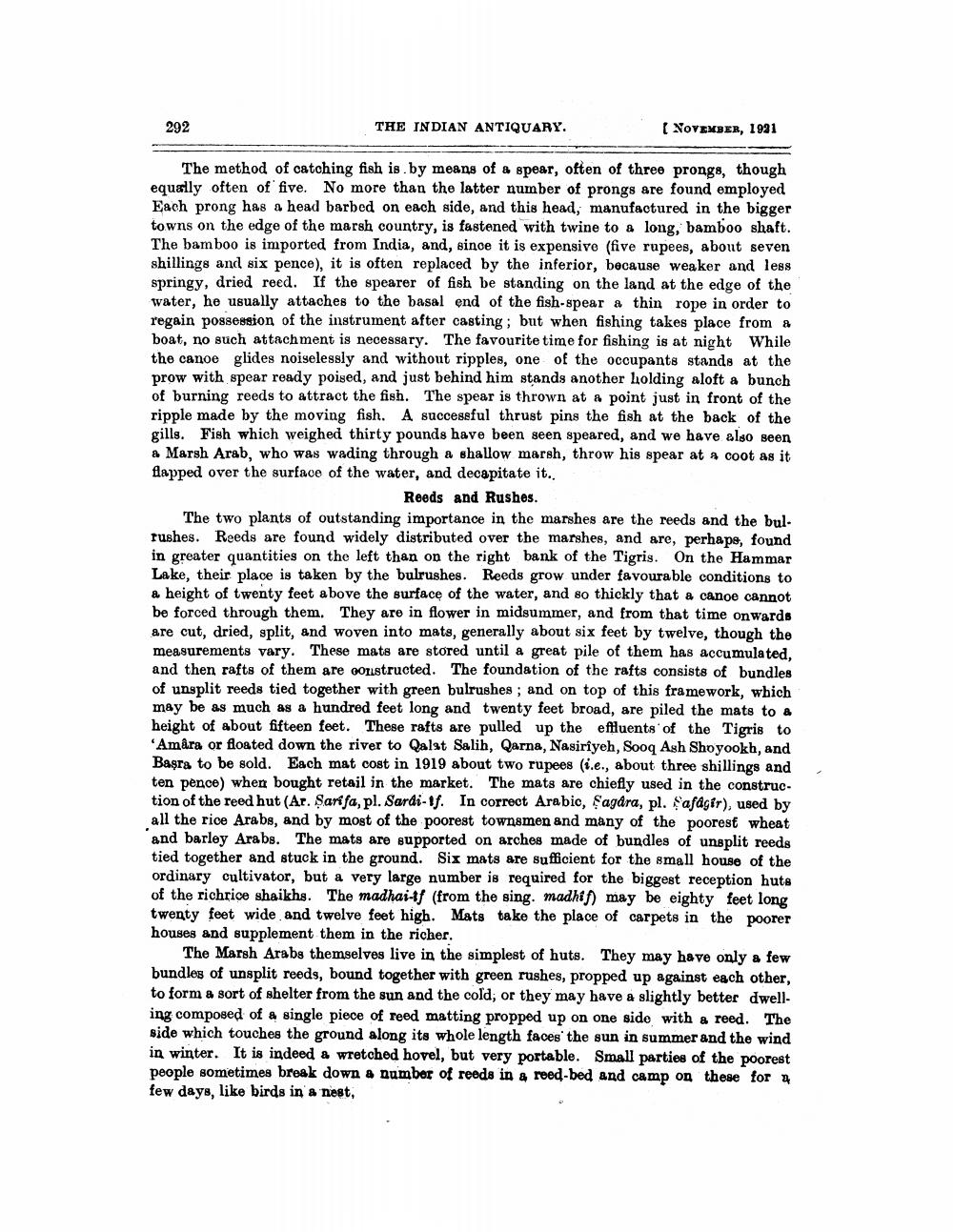________________
292
THE INDIAN ANTIQUARY.
( NOVEMBER, 1931
The method of catching fish is by means of & spear, often of three prongs, though equally often of five. No more than the latter number of prongs are found employed Each prong has a head barbed on each side, and this head, manufactured in the bigger towns on the edge of the marsh country, is fastened with twine to a long, bamboo shaft. The bamboo is imported from India, and, since it is expensive (five rupees, about seven shillings and six pence), it is often replaced by the inferior, because weaker and less springy, dried reed. If the spearer of fish be standing on the land at the edge of the water, he usually attaches to the basal end of the fish-spear a thin rope in order to regain possession of the instrument after casting, but when fishing takes place from & boat, no such attachment is necessary. The favourite time for fishing is at night While the canoe glides noiselessly and without ripples, one of the occupants stands at the prow with spear ready poised, and just behind him stands another holding aloft a bunch of burning reeds to attract the fish. The spear is thrown at a point just in front of the ripple made by the moving fish. A successful thrust pins the fish at the back of the gills. Fish which weighed thirty pounds have been seen speared, and we have also seen & Marsh Arab, who was wading through a shallow marsh, throw his spear at a coot as it flapped over the surface of the water, and decapitate it..
Reeds and Rushes. The two plants of outstanding importance in the marshes are the reeds and the bul. rushes. Reeds are found widely distributed over the marshes, and are, perhape, found in greater quantities on the left than on the right bank of the Tigris. On the Hammar Lake, their place is taken by the bulrushes. Reeds grow under favourable conditions to a height of twenty feet above the surface of the water, and so thickly that a canoe cannot be forced through them. They are in flower in midsummer, and from that time onwards are cut, dried, split, and woven into mats, generally about six feet by twelve, though the measurements vary. These mats are stored until a great pile of them has accumulated, and then rafts of them are constructed. The foundation of the rafts consists of bundles of unsplit reeds tied together with green bulrushes, and on top of this framework, which may be as much as a hundred feet long and twenty feet broad, are piled the mats to & height of about fifteen feet. These rafts are pulled up the effluents of the Tigris to Amara or floated down the river to Qalat Salih, Qarna, Nasiriyeh, Sooq Ash Shoyookh, and Başra to be sold. Each mat cost in 1919 about two rupees (i.e., about three shillings and ten pence) when bought retail in the market. The mats are chiefly used in the construction of the reed hut (Ar. Şarifa, pl. Sardi-ef. In correct Arabic, Fagdra, pl. Safagir), used by all the rice Arabs, and by most of the poorest townsmen and many of the poorest wheat and barley Arabs. The mats are supported on arches made of bundles of unsplit reeds tied together and stuck in the ground. Six mats are sufficient for the small house of the ordinary cultivator, but a very large number is required for the biggest reception huts of the richrice shaikhs. The madhai-tf (from the sing. madhi) may be eighty feet long twenty feet wide and twelve feet high. Mats take the place of carpets in the poorer houses and supplement them in the richer,
The Marsh Arabs themselves live in the simplest of huts. They may have only a few bundles of unsplit reeds, bound together with green rushes, propped up against each other, to form a sort of shelter from the sun and the cold, or they may have a slightly better dwelling composed of a single piece of reed matting propped up on one side with a reed. The side which touches the ground along its whole length faces the sun in summer and the wind in winter. It is indeed & wretched hovel, but very portable. Small parties of the poorest people sometimes break down a number of reeds in & reed-bed and camp on these for few days, like birds in a nest,




